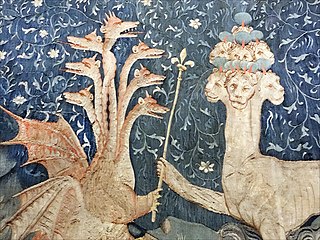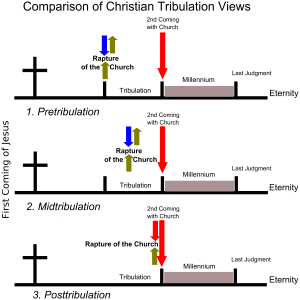Christian eschatology is a minor branch of study within Christian theology which deals with the doctrine of the "last things", especially the Second Coming of Christ, or Parousia. The word eschatology derives from two Greek roots meaning "last" (ἔσχατος) and "study" (-λογία) – involves the study of "end things", whether of the end of an individual life, of the end of the age, of the end of the world, or of the nature of the Kingdom of God. Broadly speaking, Christian eschatology focuses on the ultimate destiny of individual souls and of the entire created order, based primarily upon biblical texts within the Old and New Testaments. Christian eschatology looks to study and discuss matters such as death and the afterlife, Heaven and Hell, the Second Coming of Jesus, the resurrection of the dead, the rapture, the tribulation, millennialism, the end of the world, the Last Judgment, and the New Heaven and New Earth in the world to come.
In Christian eschatology, the Great Tribulation is a period mentioned by Jesus in the Olivet Discourse as a sign that would occur in the time of the end.

The Rapture is an eschatological position held by some Christians, particularly those of American evangelicalism, consisting of an end-time event when all dead Christian believers will be resurrected and, joined with Christians who are still alive, together will rise "in the clouds, to meet the Lord in the air." This view of eschatology is typically part of dispensational premillennialism, a form of futurism that considers various prophecies in the Bible as remaining unfulfilled and occurring in the future.
Dispensationalism is a theological framework for interpreting the Bible which maintains that history is divided into multiple ages called "dispensations" in which God interacts with his chosen people in different ways. It is often distinguished from covenant theology. These are two competing frameworks of Biblical theology that attempt to explain overall continuity in the Bible. Coining of the term "dispensationalism" has been attributed to Philip Mauro, a critic of the system's teachings, in his 1928 book The Gospel of the Kingdom.
In Christian eschatology, postmillennialism, or postmillenarianism, is an interpretation of chapter 20 of the Book of Revelation which sees Christ's second coming as occurring after the "Millennium", a messianic age in which Christian ethics prosper. The term subsumes several similar views of the end times, and it stands in contrast to premillennialism and, to a lesser extent, amillennialism.
Premillennialism, in Christian eschatology, is the belief that Jesus will physically return to the Earth before the Millennium, heralding a literal thousand-year messianic age of peace. Premillennialism is based upon a literal interpretation of Revelation 20:1–6 in the New Testament, which describes Jesus's reign in a period of a thousand years.
John Flipse Walvoord was a Christian theologian, pastor, and president of Dallas Theological Seminary from 1952 to 1986. He authored over 30 books, focusing primarily on eschatology and theology, including The Rapture Question, and was co-editor of The Bible Knowledge Commentary with Roy B. Zuck. He earned the degrees of Bachelor of Arts and Doctor of Divinity from Wheaton College, a Master of Arts degree from Texas Christian University in philosophy, a Bachelor of Theology, Master of Theology, and Doctor of Theology in systematic theology from Dallas Theological Seminary, and a Litt.D. from Liberty Baptist Seminary.

Futurism is a Christian eschatological view that interprets portions of the Book of Revelation, the Book of Ezekiel, and the Book of Daniel as future events in a literal, physical, apocalyptic, and global context.
In Christian eschatology, historicism is a method of interpretation of biblical prophecies which associates symbols with historical persons, nations or events. The main primary texts of interest to Christian historicists include apocalyptic literature, such as the Book of Daniel and the Book of Revelation. It sees the prophecies of Daniel as being fulfilled throughout history, extending from the past through the present to the future. It is sometimes called the continuous historical view. Commentators have also applied historicist methods to ancient Jewish history, to the Roman Empire, to Islam, to the Papacy, to the Modern era, and to the end time.
Kenneth L. Gentry Jr. is a Reformed theologian, and an ordained minister in the Reformed Presbyterian Church General Assembly. He is particularly known for his support for and publication on the topics of orthodox preterism and postmillennialism in Christian eschatology, as well as for theonomy and Young Earth creationism. He holds that each of these theological distinctives are logical and theological extensions of his foundational theology.
Walter C. Kaiser Jr. is an American Evangelical Old Testament scholar, writer, public speaker, and educator. Kaiser is the Colman M. Mockler distinguished Professor of Old Testament and former President of Gordon-Conwell Theological Seminary in South Hamilton, Massachusetts, retired June 30, 2006. He was succeeded by James Emery White.
Margaret MacDonald was born in 1815 in Port Glasgow, Scotland and died around 1840. She lived with her two older brothers, James and George, both of whom ran a shipping business. Beginning in 1826 and through 1829, a few preachers in Scotland emphasized that the world's problems could only be addressed through an outbreak of supernatural gifts from the Holy Spirit. In response, Isabella and Mary Campbell of the parish of Rosneath manifested charismatic experiences such as speaking in tongues. Around 1830, miraculous healings were reported through James Campbell, first of his sister Margaret MacDonald and then of Mary Campbell. Shortly thereafter, James and George MacDonald manifested the speaking and interpretations of tongues, and soon others followed suit in prayer meetings. These charismatic experiences garnered major national attention. Many came to see and investigate these events. Some, such as Edward Irving and Henry Drummond, regarded these events as genuine displays from the Holy Spirit. Others, including John Nelson Darby and Benjamin Wills Newton, whom the Plymouth Brethren sent on their behalf to investigate, came to the conclusion that these displays were demonic.
In Evangelical Christian theology, progressive dispensationalism is a variation of traditional dispensationalism. All dispensationalists view the dispensations as chronologically successive. Progressive dispensationalists, in addition to viewing the dispensations as chronologically successive, also view the dispensations as progressive stages in salvation history. The term "progressive" comes from the concept of an interrelationship or progression between the dispensations. Progressive dispensationalism is not related to any social or political use of the term progressive, such as progressive Christianity.
Leon James Wood (1918–1977) was an American theologian.

Wallie Amos Criswell Jr., was an American Baptist pastor, author, and a two-term elected president of the Southern Baptist Convention from 1968 to 1970. As senior pastor of the First Baptist Church of Dallas for five decades, he became widely known for expository biblical preaching at a popular level, and is regarded as a key figure in the late 1970s "Conservative Resurgence" within the Southern Baptist Convention.

Historic premillennialism is one of the two premillennial systems of Christian eschatology, with the other being dispensational premillennialism. It differs from dispensational premillennialism in that it only has one view of the rapture, and does not require a literal seven-year tribulation. Historic premillennialists hold to a posttribulational rapture, meaning the church is raised to meet Christ in the air after the trials experienced during the Great Tribulation. Historic premillennialism does not require that apocalyptic prophecies be interpreted literally. The doctrine is called "historic" because many early church fathers appear to have held it, including Irenaeus, Justin Martyr, and Papias. Posttribulational premillennialism is the Christian eschatological view that the second coming of Jesus Christ will occur prior to a thousand-year reign of the saints but subsequent to the Great Apostasy.

The Beast may refer to one of three beasts described in the Book of Revelation.

Benjamin Wills Newton was an English evangelist, author of Christian books, and leader of a Plymouth church. His congregation and others around Plymouth became known as the Plymouth Brethren. Newton was a friend of John Nelson Darby, a well-known leader of the Plymouth Brethren, but the two men began to clash on matters of church doctrine and practice. This led to a 1848 split of the movement into the Open Brethren and Exclusive Brethren.
Craig Alan Blaising is the former executive vice president and provost of Southwestern Baptist Theological Seminary. Blaising earned a Doctor of Theology from Dallas Theological Seminary and a Doctor of Philosophy degree at the University of Aberdeen, Scotland, a Master of Theology Dallas Theological Seminary, and a Bachelor of Science in Aerospace Engineering from the University of Texas at Austin. He is a recognized authority in patristic studies and eschatology and is one of the primary proponents of "progressive dispensationalism."
Paul David Feinberg was an American theologian, author, and professor of systematic theology and philosophy of religion at Trinity Evangelical Divinity School.







